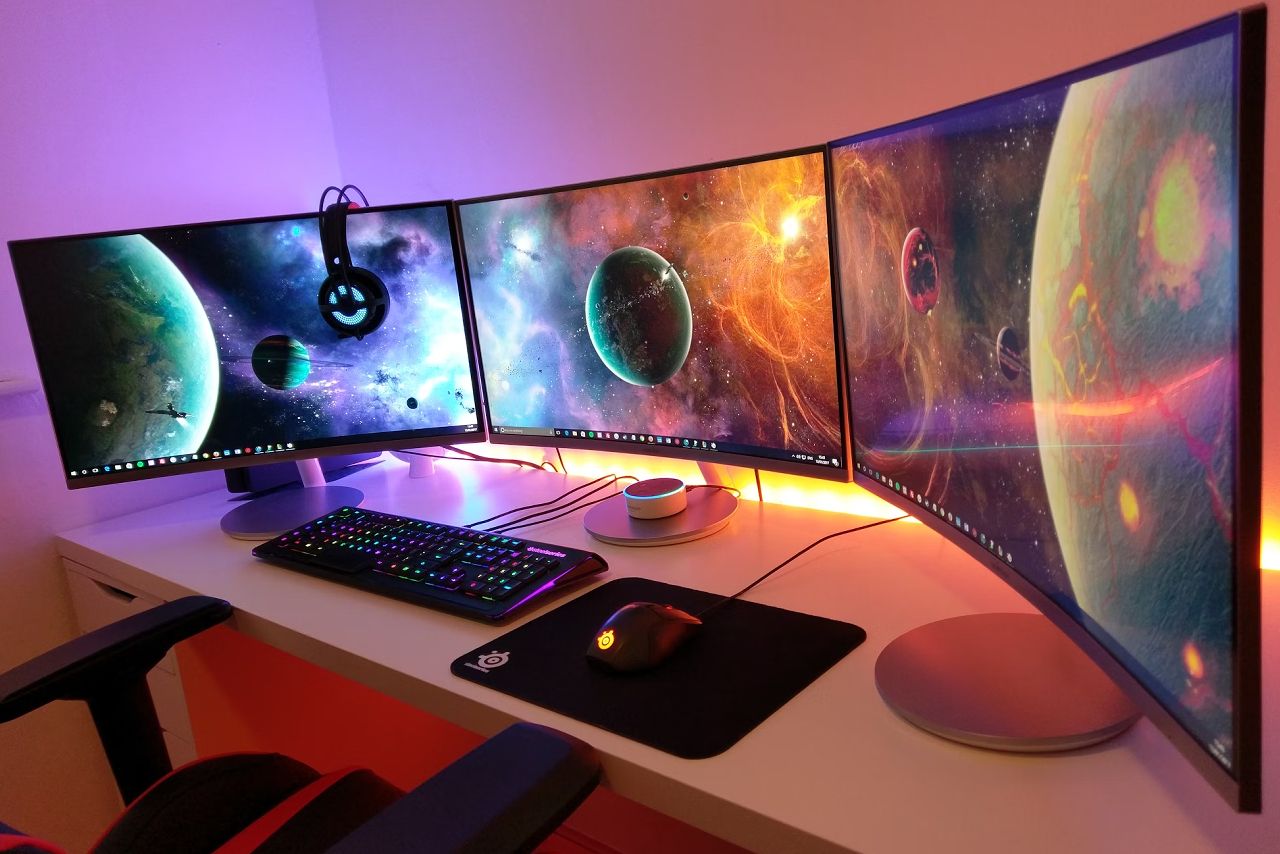
Refresh Rate: An In-Depth Guide to Smoother Gaming and Visuals
|
|
The purpose of this article is to explain what screen refresh rate is, how it works, and why it significantly impacts gameplay. We’ll explore factors to consider when choosing a monitor or TV, including panel types and synchronization technologies. Additionally, we’ll discuss how refresh rate affects dynamic scenes and examine how modern consoles and TVs handle high refresh rates for console gamers.
Table of Contents
- Introduction
- What Is Refresh Rate
- Advantages and Disadvantages of High Refresh Rate
- Display Types
- Synchronization Technologies
- Refresh Rate and Gaming Experience
- Refresh Rate on Consoles and TVs
- Practical Tips
- List of Common Misconceptions
- TL;DR
Introduction
The refresh rate of the screen is one of the key attributes that gamers and esports players primarily pay attention to. Previously, 60 Hz seemed to be the only standard, but today you can find monitors with a frequency of 120 Hz, 144 Hz, and even higher on the market. At first glance, the choice may seem excessive, but for those who strive for a smooth and responsive picture in games, this parameter is really crucial.
Regardless of whether you’re a competitive player or just enjoying action-packed single-player games, understanding the intricacies of refresh rates and the capabilities of modern displays will help you make informed choices and improve the quality of gameplay. In this article, we will try to avoid most of the redundant technical details so everyone can easily navigate the material.
What Is Refresh Rate
The refresh rate is measured in hertz (Hz) and shows how many times per second the display updates the output image. To put it simply, If the monitor is set to 60 Hz, it means that it performs 60 redraws of the screen in one second. So, at 144 Hz, there will be 144 such updates.
Physically, it looks like this: the monitor displays one frame at a time. Then, by the next moment, a new frame arrives in the display buffer, which begins to be displayed. The higher the refresh rate, the shorter the gap between the output of two consecutive frames. Meaning, on the display with higher Hz, we see smoother movement of objects in dynamic scenes.
It is important not to confuse the refresh rate of the monitor (hertz) with the frame rate of the game (frames per second). Seeing the 120 FPS value in the game may suggest twice the smoothness of 60 FPS, however, a 60 Hz monitor can only display 60 frames per second. It physically cannot display more than 60 full redraws per second. Excess frames disappear or generate additional artifacts if vertical synchronization is not enabled.
On the other hand, in order to unlock the monitor’s potential, it’s necessary that the video card can produce an appropriate or higher number of frames per second. For example, if you have a 144 Hz monitor, but the graphics card is loaded and outputs only 60-80 FPS, then you will not get the full advantage of high frequency. It’s all about system performance.

Advantages and Disadvantages of High Refresh Rate
The high refresh rate provides several tangible advantages:
- Smoother movement—objects in the game move without sudden jolts and breaks.
- Reduced blurriness—at frequencies above 60 Hz, the blur from fast objects is noticeably reduced.
- Increased responsiveness—due to the shorter time between frame updates, the player can react faster to changes in the game.
- Eye comfort—frequent updates feel more natural, which reduces the vision strain.
However, there are disadvantages:
- Price—good monitors with a high refresh rate (especially 240 Hz or more) are usually more expensive than their counterparts with 60-75 Hz.
- Hardware requirements—to consistently output 120+ FPS, you need a more powerful graphics card and an appropriate processor.
- Nuances of the software—some games may have optimization problems, not all applications can work correctly with very high frequencies.
The usability of 240+ Hz displays remains debatable. For esports athletes and competitive players, they can provide a somewhat noticeable advantage (usually in fighting games, shooters, or MOBAs). But for most players, a stable 120-144 Hz will be enough to get a smooth picture and avoid overpaying.
Display Types
Image quality and high refresh rate support capabilities are largely determined by the type of matrix used.
Twisted nematic (TN display)
One of the oldest panel types, but at the same time the fastest in terms of response. It has a relatively low price, and is often the first to receive high frequencies. The main disadvantages are faded colors and weak viewing angles.
In-plane switching (IPS display)
The main advantage is accurate color reproduction and wide viewing angles. Previously, IPS panels suffered from increased response time, but modern models with advanced technologies can operate at 144 Hz or more. At the same time, they are more expensive than TN-analogues.
Vertical alignment (VA display)
A compromise between TN and IPS. It is inferior to IPS in viewing angles and color accuracy, but it shows better contrast and can achieve higher refresh rates. Some models have problems with dark scenes, which can be inconvenient for gaming.
Organic light-emitting diode (OLED display)
It is still fairly expensive, but popular in TVs. The advantages are the deep black color, excellent contrast, and instant response. There are models with a high refresh rate (120 Hz and higher). However, the risk of burn-in from static images remains a problem, while the high cost makes OLED panels a premium choice for gamers.
When choosing a monitor, you should not only look at the refresh rate, but also consider the type of matrix to find the optimal ratio of picture quality, speed, and price.

Synchronization Technologies
Along with the increase in the refresh rate, there is a need for additional methods that synchronize the operation of the GPU and monitor, reducing tearing, stuttering, and other related problems (this has been covered in detail in another article).
VSync
The simplest method of vertical synchronization. It binds the rendering of frames in the game to the refresh rate of the monitor. As a result, the tearing disappears, but an additional input delay is possible. If the FPS in the game drops below the refresh rate, stuttering may appear.
FreeSync
Adaptive synchronization technology from AMD. It provides an adjustment of the refresh rate to the real FPS of the game. In other words, if the game outputs 80 FPS, the monitor switches to 80 Hz too, eliminating gaps and maintaining smoothness. The FreeSync option is usually cheaper to implement, but requires compatible GPU and monitor supporting the standard.
G-SYNC
Similar adaptive technology from NVIDIA. It requires a separate hardware module in the monitor, which affects the final price of the device. With its help, very accurate frame synchronization is achieved.
In addition to these methods, a broader category of variable refresh rate (VRR) technologies exists. The main idea remains the same: adjust the refresh rate of the display to the current FPS in the game to eliminate visual artifacts and maintain responsive controls.
Refresh Rate and Gaming Experience
Smooth picture
Many people are concerned about the question: is the human eye really able to distinguish the difference between 60 and 144 Hz, or 144 and 240 Hz? It’s difficult to answer unequivocally, because this is a subjective thing. Some people have a higher threshold for smoothness perception, and they accurately determine that a 60 Hz monitor produces a “ragged” picture compared to 120-144 Hz. Others may not notice the critical difference.
However, in dynamic scenes, especially in shooters, faster movements are often felt with an increased refresh rate. This brings not only visual convenience, but also gameplay advantages: you see the enemy more clearly and have time to aim and shoot faster.
Competitive advantage
Professional players actively use 144+ Hz monitors. The reason is simple: every microsecond of delay can be a decisive factor in a high-level duel. Most esports players note that the gap from 60 Hz is huge, and the transition to 240 Hz relative to 144 Hz is less striking, but it is still noticeable in some moments.
If your goal is a competitive level of play and you want to maximize your chances of success, it makes sense to invest in a monitor with a high refresh rate. But don’t forget that to achieve stable 144 or 240 FPS in modern games, you will need a powerful rig. Professionals often play on lowered graphics settings to ensure high and stable FPS.
Eye strain
Visual strain during long gaming sessions is a topic relevant to many gamers. A high refresh rate does not completely solve the problem of eye fatigue, but it gives a certain advantage: a smoother picture less irritating to the visual apparatus when there are many moving objects on the screen. On the other hand, if you spend hours sitting in front of a monitor with high brightness and contrast, the lack of breaks and proper eye exercises will still have a negative impact.
Thus, even if you have a 240 Hz monitor, you should follow the basic rules of visual hygiene: take breaks every half hour or an hour, light the room well, and use the eye comfort or low blue light modes (if available) to reduce the strain.
Refresh Rate on Consoles and TVs
Current generation of consoles (PlayStation 5, Xbox Series X or S). They already support an output mode of up to 120 frames per second in some games. Accordingly, TV manufacturers have begun to focus on models capable of operating at 120 Hz at 4K resolution (or at least at 1080p). However, the TV market is different from the computer monitor market: frame interpolation and marketing terms like “motion rate 240” are often used there, which do not always mean the actual physical refresh rate.
To find a TV that is really suitable for gaming, you need to look at the specifications, which explicitly state the support for 120 Hz, as well as study the versions of the HDMI ports. The HDMI 2.1 standard allows you to transmit a 4K signal with a frequency of 120 Hz at a sufficiently high bitrate, but not all mid-range TV models are equipped with a full set of necessary functions.
Recently, there have also been OLED TVs with a refresh rate of 120 Hz, which are famous for their excellent image. They provide minimal response time, which makes the gameplay really smooth and colorful. But their cost can be quite significant, and OLED technology still has a risk of burnout with static HUD elements.
Additionally, VRR is available on some TVs. PlayStation 5 and Xbox Series support similar mechanisms, although the exact compatibility and effectiveness depend on the specific TV model.
Should console gamers switch to TVs with a high refresh rate?
The main question is: how justified is it to buy an expensive 120 Hz TV for the sake of several games that can actually produce such indicators on the console? If console gaming is your main leisure activity, and you plan to enjoy not only story projects, but also competitive shooters, then you will feel the real benefits. Increased smoothness of movements and responsive controls will be noticeable.
On the other hand, if you mostly watch movies, TV series, and sometimes play slow-paced adventure games, then there may be no particular need to overpay for real 120 Hz support. After all, there is still relatively little content that can unlock the potential of such a TV. For some gamers, it’s easier to stay at the traditional 60 Hz and spend the budget on upgrading something else.

Practical Tips
Resolution and performance recommendations
In addition to the refresh rate, screen resolution plays an important role. Displays with resolutions of Full HD (1920×1080), QHD (2560×1440) and 4K (3840×2160) load the system differently. If you are aiming for 144 Hz and above, then it will be extremely difficult to get a similar FPS in 4K without a very expensive GPU.
- Full HD at 144 or 240 Hz—the optimal solution for competitive gamers who care about maximum speed and whether games deliver 200+ FPS.
- QHD at 144 or 165 Hz—a compromise between image size and refresh rate. Suitable for advanced users with more powerful hardware.
- 4K at 120 Hz and above—already a premium segment. Top-end components are needed here to achieve real FPS corresponding to the refresh rate.
Do not forget that some monitors are supplied with factory overclocking (for example, the 120 Hz model can accelerate to 144 Hz). When buying, it is worth checking real tests and user reviews to make sure that the operation is stable at an increased frequency.
Accounting for response time
The refresh rate is not the only parameter that affects the sharpness and smoothness of the image. The response time, expressed in milliseconds (ms), shows how long it takes for a pixel to change from one brightness (or color) to another. There are several measurement methods (Grey-to-Grey, MPRT), and not all manufacturers provide the same quality.
- The low response (1-4 ms GTG) is considered an excellent indicator for games: it minimizes the plume and ghosting of moving objects.
- A high response time (10 ms or more) can lead to noticeable blurring of the dynamics.
If you are buying a monitor with a frequency of 144 Hz or higher, you should pay special attention to ensure that the response time is as short as possible. Otherwise, the claimed advantages of a high refresh rate are partially offset by the appearance of loops.
List of Common Misconceptions
60 Hz is enough for everyone
One of the most common myths is that you don’t need more than 60 Hz anyway. Proponents of this approach claim that the human eye is supposedly incapable of noticing the difference. In practice, many gamers immediately notice a smoother movement when switching from 60 to 120-144 Hz. This is especially important in competitive games.
However, there are cases where 60 Hz is sufficient. If you don’t play fast competitive games and don’t pay attention to the smallest details of movement, or have a low-end GPU, you can easily do with the classic 60 Hz. It all depends on personal preferences and tasks.
Human eyes can’t see more than 24/30/60 FPS
This myth originates from the film industry and the classical frame rate (24 frames per second for films, 30 for television broadcasting). Movies additionally use the motion blur effect and other techniques to compensate for the small number of frames. But in interactive games, where instant reaction is important, everything works differently.
The human brain is not limited to a certain hard limit of several frames. Perhaps after a certain milestone, the difference becomes less noticeable, but for competitive gaming, each additional frame can increase accuracy. Therefore, the belief that the eyes will not see anyway is not correct.
TL;DR
In this article, we explored why refresh rates matter for gamers, why there’s such a broad selection of monitors and TVs with different Hz values, and which factors to consider before buying. Higher refresh rates can offer smoother visuals, faster response, and less eye strain—but it’s essential to balance your needs, budget, and system capabilities.
Competitive players tend to favor 144 Hz as a solid standard. If you’ve got powerful hardware and the budget, 240 Hz can offer an extra edge, but in most cases are overkill. Casual gamers often find 60–75 Hz sufficient if rich colors and higher resolution matter more (or a small hardware budget).
Also pay attention to panel type (TN, IPS, VA, OLED), response time, adaptive sync range, and whether you need DisplayPort or HDMI 2.1 (especially for newer consoles). The display should match not only your preferred playstyle but also your system’s performance.
If you decide to upgrade to a higher refresh rate, check tests and reviews to ensure your GPU can handle those framerates in practice. Manufacturer claims don’t always reflect real-world conditions. Confirm that FreeSync or G-SYNC is supported to avoid tearing and input lag.
Ultimately, the perfect monitor or TV choice depends on your priorities. Some seek a competitive advantage, others want a smooth cinematic feel in big AAA titles, while some only play a few hours weekly and may not even notice a jump from 60 to 120 Hz. Being familiar with refresh rates, response times, FPS, and sync technologies will help you pick a display that truly enhances your gaming.













